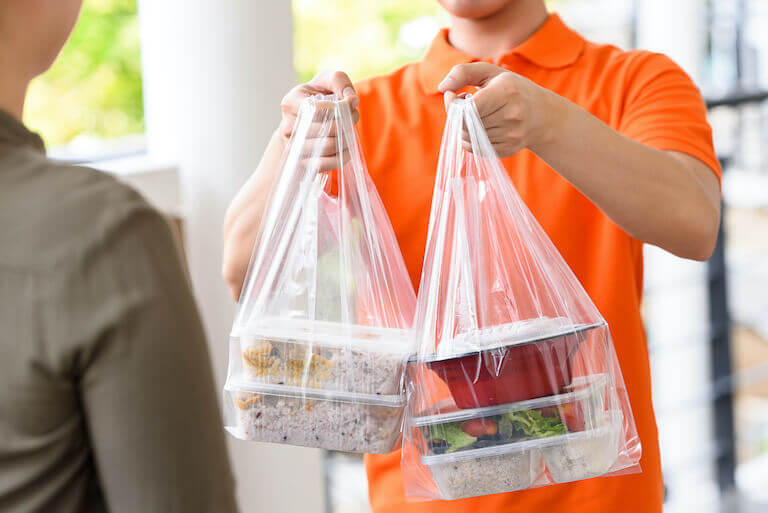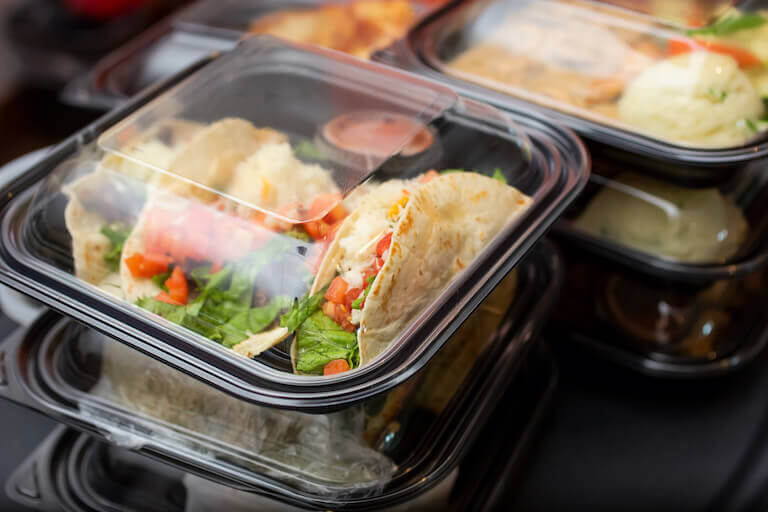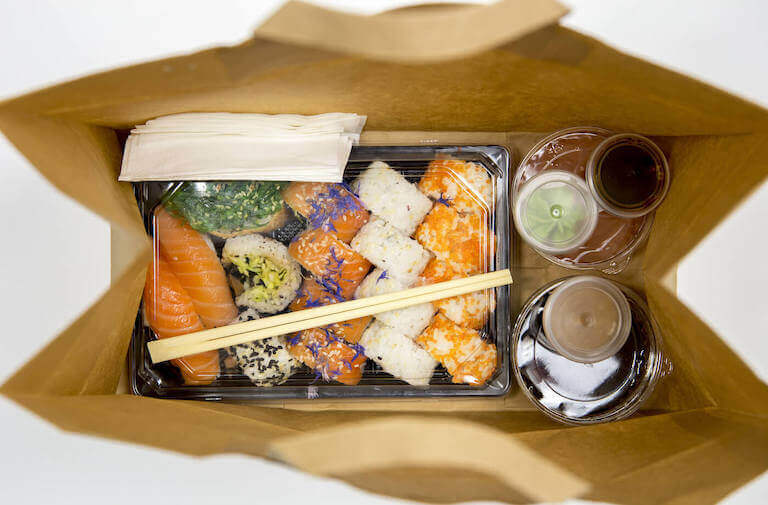Gone are the days when restaurant delivery was limited to calling in a pie from your neighborhood pizza joint. Thanks to the advent of food delivery apps like DoorDash and Uber Eats, diners now want everything from their favorite Thai curry to lobster mac and cheese delivered to their door – and ordered without a phone call.
Even after the pandemic begins to wane, the demand for delivery has not only remained, but it’s increased. In fact, online food delivery revenue is predicted to increase by over 9%1 in the next two years. To help you capitalize on this increase, we’re going to cover exactly how you can design a delivery-friendly menu that will have customers coming back for more.
Choose Items That Will Travel Well
While in-house diners will eat their meals a few minutes after they are prepared, delivery customers may not enjoy their food until an hour after it leaves the kitchen. After paying for their meal and the delivery fee, they won’t be happy receiving a soggy sandwich or overcooked steak. One of the reasons pizza has been such a staple in the delivery world for so long is its transportability. If you’re not offering pizza, think through what else could travel well.
Technically, you can deliver any type of dish. But doing so can jeopardize your restaurant or food truck’s reputation as well as your bottom line. Therefore, it’s helpful to learn how to design different types of menus for different circumstances – dine-in or delivery.
Foods That Work Well For Delivery
These items have a texture and presentation that holds up well in delivery.
- Burritos and burrito bowls
- Tacos
- Burgers
- Stews and chilis
- Curries
- Dry noodle dishes like pad thai and lo mein
- Smoked barbeque meats
- Pizza
- Chicken wings
- Sandwiches
Rather than listing your whole menu as available for delivery, you might only include options that will hold up well in transit. While a freshly dressed salad or a piping hot tray of loaded nachos may be some of the most popular items on your menu, they’re likely to become soggy during the half-hour delivery drive. Other items that don’t hold up well in transit include fried foods and heavily sauced pasta.

Modify Dishes that Rely on Exquisite Presentation
Along with thinking about how a dish’s texture holds up during delivery, consider presentation. Any great chef knows that plating can have a big impact on a dish’s overall success. However, it’s difficult to adapt an aesthetically pleasing presentation from a plate to a take-out container. If you have a dish that relies on exquisite garnishes and sauce designs, opening up a jumbled delivery box will provide diners with a much different experience.
Instead of scrapping menu items entirely, consider modifying some of your most popular dishes into delivery-friendly options. Swap the whole lobster for a lobster roll and a filet mignon for a steak sandwich, for example.
“I also learned about menu design, what people actually look at first in a menu, and what items you should put in.”
Damian Palacios, Escoffier Online Culinary Arts Graduate*
Consider Preparation Time
While delivery orders won’t crowd your restaurant with seated customers, they’ll still add tickets to your kitchen. Just like when you’re developing a dine-in menu, you’ll need to consider how long it will take to fill these orders.
COVID-19 Spurred an Increased Demand for Delivery
- Before COVID-19, food delivery was growing at 8% per year. However, this market more than doubled during the first year of the pandemic.2
- DoorDash revenue grew from $362 million in Q1 of 2020 to $1.3 billion in Q4 of 2021.3
Sure, delivery customers expect to wait for their food to arrive. However, if their food takes twenty minutes longer to get out of the kitchen than you estimated, you’ll end up with hangry customers – and possibly poor reviews that could mar your delivery reputation.
Along with considering how long dishes take to prepare, think about the added time of packaging food in to-go containers and bags.

Think About Packaging
Just as proper plating is key to dine-in service, choosing the right containers is crucial if you want to deliver orders. Proper packaging helps keep food safe and contained – no delivery driver wants a car full of hot soup, and patrons will appreciate when their sandwich isn’t smushed!
However, when you’re choosing delivery containers, you’ll need to think about more than a container’s ability to hold food. Consider the following factors as well.
- Material cost: Higher sales may allow you to spend more money on delivery containers. In general, packaging costs should be equivalent to 1-4% of the restaurant’s net sales. Styrofoam containers are typically the cheapest, followed by paper, aluminum, and plastic.
- Sustainability: If you run a restaurant that boasts zero-waste, local ingredients, or other sustainability factors, your customers may expect sustainable packaging. While styrofoam and plastic containers are made from fossil fuels, you can also find packaging made from renewable materials like wood and sugarcane fibers. Additionally, some products are recyclable or compostable while others must be disposed of.
- Ability to reheat: If you offer a wide delivery radius, you may want to look for containers that customers can reheat in the microwave or oven.
By considering the importance of each of these factors, you can find a container that suits your restaurant’s needs and style. For example, styrofoam containers are great if price is your biggest concern, but they’re not great for the environment. And while paper boxes can be composted and reheated, they’re not the best option if you need a leak-proof container.

Learn the Fundamentals of Menu Design
Before you can build a menu that will have delivery customers raving, you need to learn the components of any successful menu. Whether you’re running a ghost kitchen, food truck, or restaurant, your menu will impact your purchasing, prep time, and profits. That means throwing together a menu based on your favorite dishes isn’t always the best option.
If you can’t confidently design a menu, there’s no shame in learning from professionals like Chef Instructors. Escoffier’s Culinary Arts program offers an entire course in the curriculum on menu design and management, where students can learn everything from visual design to price analysis.
Check out these articles about food entrepreneurship next:
- How Many Employees Does it Take to Run a Restaurant?
- Positioning Statements for Restaurant Marketing
- How to Start a Restaurant With Little to No Money
This article was originally published on February 8, 2019, and has since been updated.
*Information may not reflect every student’s experience. Results and outcomes may be based on several factors, such as geographical region or previous experience.
1https://www.statista.com/outlook/dmo/eservices/online-food-delivery/united-states
2https://www.mckinsey.com/ordering-in-the-rapid-evolution-of-food-delivery_vf.pdf
3https://www.mckinsey.com/industries/technology-media-and-telecommunications/our-insights/ordering-in-the-rapid-evolution-of-food-delivery

 “I also learned about menu design, what people actually look at first in a menu, and what items you should put in.”
“I also learned about menu design, what people actually look at first in a menu, and what items you should put in.”